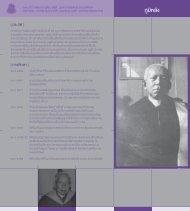You also want an ePaper? Increase the reach of your titles
YUMPU automatically turns print PDFs into web optimized ePapers that Google loves.
82found there (Rudman 1912). On the immediate north of Mandla townthere is a sizeable stretch of black soil. Another pocket of black soil ofconsiderable size is found around Narayanganj Community Developmentblock headquarters on the northwest of Mandla.Gonds who speak a Dravidian language and the Baigas who speakAustro-Asiatic Kolarian are the two aboriginal tribes inhabiting thedistrict. Now both of them have forgotten their original mother tongueand instead speak some local versions of Hindi (national language ofIndia). The Gonds, who are numerically a large tribal group in India,occupy the entire central and eastern Madhya Pradesh, parts ofMaharastra, Andhra Pradesh, Bihar, Chattrisgarh, Jharkhand and parts ofWest Bengal. They constitute nearly half of the total population of Mandlaand are widely distributed in the district. Mandla has a long history ofRajput-Gond (Hinduised Gonds) rules. The present day territory of theMandla district historically was a backward hinterland of Garha-Mandlakingdom at Garha (the present day district of Jabalpur). The capital of theGarha-Mandla kingdom was shifted from Garha (at Jabalpur) toRamnagar-Mandla (at Mandla) in 1670c during the rule of Hirde Shah(Rudman 1912). Compared to the Gonds, the Baigas always remained asmall group and techno-economically more primitive concentrated on thefringe areas of the eastern Madhya Pradesh and Chhattisgarh. At present,the Baigas constitute about five per cent of the district’s population.Until the 20 th Century, the Baigas had been solely dependent onswidden cultivation, locally called bewar, supplemented by hunting,fishing and collecting forest products. The Gonds on the other hand havetaken to ploughing quite way back in early 18 th century or even before.Nicknamed kishan, meaning “the cultivators”, the Gonds traditionallypractised a primitive form of plough cultivation called dhya. Unlike themore primitive bewar cultivation, the Gonds cut wood and shrubs fromthe nearby forest; bring them to dry on the plot and later burned them.Then they ploughed the ashes into the soil. The dhya method, arguably anintermediate between ploughing and bewar, could be an improved versionof bewar cultivation in which ploughing was introduced. In 1869, abouthalf of the Gonds practised plough cultivation, one-fourth dhya and onefourtha combination of the two (McEldowney 1980). The district ofMandla is also inhabited by several Hindu farming castes (e.g. Lodhis andKurmis), who have come from other districts of Madhya Pradesh andadjoining states. In the 17 th century, Hirde Shah invited various Hinducastes into the district to take up agricultural activity (Rudman 1912).Roy



